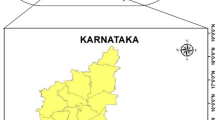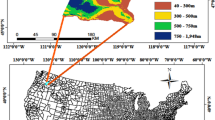Abstract
Soil moisture (SM) at the interface between the land surface and atmosphere is one of the major environmental parameters which plays an important role in hydrological applications. In this article, the SM measured by Soil Moisture Active Passive (SMAP) is downscaled from 3- to 1-km spatial resolution. The main purpose is to evaluate the performance of two different downscaling methods over a variety of climatic conditions and land cover types. These two methods, based on regression and artificial neural network (ANN), are used for enabling us to cross-validate and reliably interpret the obtained results since the number of ground measurements is not sufficient for accuracy assessment. These methods are applied over four different case studies; one is located in the USA, i.e., state of Utah (semi-arid), and the remaining three are located in Iran, i.e., Fars (arid and semi-arid), Yazd (hyper-arid), and Golestan (humid). In both methods, different combinations of input features correlated with SM including land surface temperature (LST), normalized difference vegetation index (NDVI), brightness temperatures in horizontal and vertical polarizations (TBH and TBV), shortwave infrared (SWIR), and digital elevation model (DEM) are used. It is found that the DEM does not add extra information in downscaling. The reason is due to high correlation between topography and LST. Moreover, SWIR is most likely able to model only large-scale variations of SM. The downscaled SM products are then compared to 1-km resolution SMAP SM extracted from Sentinel-1 for the study areas in Iran and in situ measurements in Utah. Both methods produce results which are considerably consistent except that the regression method adds more spatial details in the downscaled SM. The achievements illustrate that the performance of both downscaling methods is higher in areas with more homogeneous climatic conditions, i.e., Yazd and Golestan. The best evaluation metrics including correlation coefficient (R), root mean square error (RMSE), and mean absolute percentage error (MAPE) for Yazd and Golestan are R = 0.89, RMSE = 0.025 m3/m3, and MAPE = 21.13% and R = 0.93, RMSE = 0.044 m3/m3, and MAPE = 21.95%, respectively. Moreover, large model biases are associated with dense vegetated areas and high altitudes. The best downscaling accuracy in both methods over all study areas belongs to bare soil and flat regions.










Similar content being viewed by others
Data availability
The datasets generated and/or analyzed during the current study are available from the corresponding author on reasonable request.
References
Asakereh, H., & Mazini, F. (2010). Analysis of the probability distribution for the annual precipitation in the Golestan province. Iran-Water Resources Research, 6(1), 51–55.
Alemohammad, S. H., Kolassa, J., Prigent, C., Aires, F., & Gentine, P. (2018). Global downscaling of remotely sensed soil moisture using neural networks. Hydrology and Earth System Sciences, 22(10), 5341–5356.
Abbaszadeh, P., Moradkhani, H., & Zhan, X. (2019). Downscaling SMAP radiometer soil moisture over the CONUS using an ensemble learning method. Water Resources Research, 55(1), 324–344.
Babaeian, E., Sadeghi, M., Franz, T. E., Jones, S., & Tuller, M. (2018). Mapping soil moisture with the OPtical TRApezoid Model (OPTRAM) based on long-term MODIS observations. Remote Sensing of Environment, 211, 425–440.
Chen, Q., Fang, M., Wang, H., Xu, Z., Tang, Z., Yang, L., & Qi, S. (2020). Downscaling of satellite remote sensing soil moisture products over the tibetan plateau based on the random forest algorithm: Preliminary results. Earth and Space Science, 7, 1–16.
Choi, M., & Hur, Y. (2012). A microwave-optical/infrared disaggregation for improving spatial representation of soil moisture using AMSR-E and MODIS products. Remote Sensing of Environment, 124, 259–269.
Colliander, A., Fisher, J. B., Halverson, G., Merlin, O., Misra, S., Bindlish, R., et al. (2017). Spatial downscaling of SMAP soil moisture using MODIS land surface temperature and NDVI during SMAPVEX15. IEEE Geoscience and Remote Sensing Letters, 14(11), 2107–2111.
Das, N. N., Entekhabi, D., Njoku, E. G., Shi, J. J., Johnson, J. T., & Colliander, A. (2013). Tests of the SMAP combined radar and radiometer algorithm using airborne field campaign observations and simulated data. IEEE Transactions on Geoscience and Remote Sensing, 52(4), 2018–2028.
Entekhabi, D., Njoku, E. G., O'neill, P. E., Kellogg, K. H., Crow, W. T., Edelstein, W. N., et al. (2010). The soil moisture active passive (SMAP) mission. Proceedings of the IEEE, 98(5), 704–716.
Guevara, M., & Vargas, R. (2019). Downscaling satellite soil moisture using geomorphometry and machine learning. PLoS One, 14(9), e0219639.
Henderson-Sellers, A. (1996). Soil moisture: A critical focus for global change studies. Global and Planetary Change, 13(1-4), 3–9.
Hassan-Esfahani, L., Torres-Rua, A., Jensen, A., & McKee, M. (2015). Assessment of surface soil moisture using high-resolution multi-spectral imagery and artificial neural networks. Remote Sensing, 7(3), 2627–2646.
Jackson, T. J. (1993). III. Measuring surface soil moisture using passive microwave remote sensing. Hydrological Processes, 7(2), 139–152.
Jiang, H., Shen, H., Li, H., Lei, F., Gan, W., & Zhang, L. (2017). Evaluation of multiple downscaled microwave soil moisture products over the central Tibetan Plateau. Remote Sensing, 9(5), 402.
Kerr, Y. H., Al-Yaari, A., Rodriguez-Fernandez, N., Parrens, M., Molero, B., Leroux, D., et al. (2016). Overview of SMOS performance in terms of global soil moisture monitoring after six years in operation. Remote Sensing of Environment, 180, 40–63.
Kim, J., & Hogue, T. S. (2011). Improving spatial soil moisture representation through integration of AMSR-E and MODIS products. IEEE Transactions on Geoscience and Remote Sensing, 50(2), 446–460.
Kolassa, J., Aires, F., Polcher, J., Prigent, C., Jimenez, C., & Pereira, J. M. (2013). Soil Moisture retrieval from multi instrument observations: Information content analysis and retrieval methodology. Journal of Geophysical Research-Atmospheres, 118, 4847–4859.
Kolassa, J., Gentine, P., Prigent, C., & Aires, F. (2016). Soil moisture retrieval from AMSR-E and ASCAT microwave observation synergy. Part 1: Satellite data analysis. Remote Sensing of Environment, 173(6), 1–14.
Liu, Y., Jing, W., Wang, Q., & Xia, X. (2020). Generating high-resolution daily soil moisture by using spatial downscaling techniques: A comparison of six machine learning algorithms. Advances in Water Resources, 141, 103601.
Li, Q., Wang, Z., Shangguan, W., Li, L., Yao, Y., & Yu, F. (2021). Improved daily SMAP satellite soil moisture prediction over China using deep learning model with transfer learning. Journal of Hydrology, 600, 126698.
Merlin, O., Walker, J. P., Chehbouni, A., & Kerr, Y. (2008). Towards deterministic downscaling of SMOS soil moisture using MODIS derived soil evaporative efficiency. Remote Sensing of Environment, 112(10), 3935–3946.
Merlin, O., Al Bitar, A., Walker, J. P., & Kerr, Y. (2010). An improved algorithm for disaggregating microwave-derived soil moisture based on red, near-infrared and thermal-infrared data. Remote Sensing of Environment, 114(10), 2305–2316.
Merlin, O., Rudiger, C., Al Bitar, A., Richaume, P., Walker, J. P., & Kerr, Y. H. (2012). Disaggregation of SMOS soil moisture in Southeastern Australia. IEEE Transactions on Geoscience and Remote Sensing, 50(5), 1556–1571.
Merlin, O., Escorihuela, M. J., Mayoral, M. A., Hagolle, O., Al Bitar, A., & Kerr, Y. (2013). Self-calibrated evaporation-based disaggregation of SMOS soil moisture: An evaluation study at 3 km and 100 m resolution in Catalunya, Spain. Remote Sensing of Environment, 130, 25–38.
ElSaadani, M., Habib, E., Abdelhameed, A. M., & Bayoumi, M. (2021). Assessment of a spatiotemporal deep learning approach for soil moisture prediction and filling the gaps in between soil moisture observations. Frontiers n Artificial Intelligence, 4, 1–14.
Piles, M., Camps, A., Vall-Llossera, M., Corbella, I., Panciera, R., Rudiger, C., et al. (2011). Downscaling SMOS-derived soil moisture using MODIS visible/infrared data. IEEE Transactions on Geoscience and Remote Sensing, 49(9), 3156–3166.
Piles, M., Sánchez, N., Vall-llossera, M., Camps, A., Martínez-Fernández, J., Martinez, J., & González-Gambau, V. (2014). A downscaling approach for SMOS land observations: Evaluation of high-resolution soil moisture maps over the Iberian Peninsula. IEEE Journal of Selected Topics in Applied Earth Observations and Remote Sensing, 7(9), 3845–3857.
Portal, G., Vall-Llossera, M., Piles, M., Camps, A., Chaparro, D., Pablos, M., & Rossato, L. (2018). A spatially consistent downscaling approach for SMOS using an adaptive moving window. IEEE Journal of Selected Topics in Applied Earth Observations and Remote Sensing, 11(6), 1883–1894.
Rodriíguez-Fernández, N. J., Aires, F., Richaume, P., Kerr, Y. H., Prigent, C., Kolassa, J., Cabot, F., Jimenez, C., Mahmoodi, A., & Drusch, M. (2015). Soil moisture retrieval using neural networks: Application to SMOS. IEEE Transactions on Geoscience and Remote Sensing, 53, 5991–6007.
Sadeghi, M., Jones, S. B., & Philpot, W. D. (2015). A linear physically-basedmodel for remote sensing of soil moisture using short wave infrared bands. Remote Sensing of Environment, 164, 66–76.
Sadeghi, M., Babaeian, E., Tuller, M., & Jones, S. B. (2017). The optical trapezoid model: A novel approach to remote sensing of soil moisture applied to Sentinel-2 and Landsat-8 observations. Remote Sensing of Environment, 198, 52–68.
Sánchez-Ruiz, S., Piles, M., Sánchez, N., Martínez-Fernández, J., Vall-llossera, M., & Camps, A. (2014). Combining SMOS with visible and near/shortwave/thermal infrared satellite data for high resolution soil moisture estimates. Journal of Hydrology, 516, 273–283.
Salmani-Dehaghi, N., & Samani, N. (2019). Spatiotemporal assessment of the PERSIANN family of satellite precipitation data over Fars Province. Iran. Theoretical and Applied Climatology, 138, 1333–1357.
Sishah, S., Abrahem, T., Azene, G., Dessalew, A., & Hundera, H. (2023). Downscaling and validating SMAP soil moisture using a machine learning algorithm over the Awash River basin, Ethiopia. PLoS One, 18(1), e0279895.
Van Zyl, J. J. (2001). The Shuttle Radar Topography Mission (SRTM): A breakthrough in remote sensing of topography. Acta Astronautica, 48(5-12), 559–565.
Xu, M., Yao, N., Yang, H., Xu, J., Hu, A., de Goncalves, L. G. G., & Liu, G. (2022). Downscaling SMAP soil moisture using a wide & deep learning method over the Continental United States. Journal of Hydrology, 609, 127784.
Yao, R., Yang, J., Gao, P., Shao, H., Chen, X., & Yu, S. (2013). Multivariate simulation and assessment of three dimensional spatial patterns of coastal soil salinity using ancillary variables. Fresenius Environmental Bulletin, 22(1), 39–52.
Zhao, H., Li, J., Yuan, Q., Lin, L., Yue, L., & Xu, H. (2022). Downscaling of soil moisture products using deep learning: Comparison and analysis on Tibetan Plateau. Journal of Hydrology, 607, 127570.
Zhang, Y., Liang, S., Ma, H., He, T., Wang, Q., Li, B., Xu, J., Zhang, G., Liu, X., & Xiong, C. (2023). Generation of global 1-km daily soil moisture product from 2000 to 2020 using ensemble learning. Earth System Science Data, 15(5), 2055–2079.
Author information
Authors and Affiliations
Contributions
Fatemeh Imanpour: methodology, validation, resources, data curation, formal analysis. Maryam Dehghani: conceptualization, writing—original draft, supervision. Mehran Yazdi: supervision, writing—review and editing.
Corresponding author
Ethics declarations
Competing interests
The authors declare no competing interests.
Additional information
Publisher’s note
Springer Nature remains neutral with regard to jurisdictional claims in published maps and institutional affiliations.
Supplementary Information
ESM 1
(DOCX 912 kb)
Rights and permissions
Springer Nature or its licensor (e.g. a society or other partner) holds exclusive rights to this article under a publishing agreement with the author(s) or other rightsholder(s); author self-archiving of the accepted manuscript version of this article is solely governed by the terms of such publishing agreement and applicable law.
About this article
Cite this article
Imanpour, F., Dehghani, M. & Yazdi, M. Improving SMAP soil moisture spatial resolution in different climatic conditions using remote sensing data. Environ Monit Assess 195, 1476 (2023). https://doi.org/10.1007/s10661-023-12107-7
Received:
Accepted:
Published:
DOI: https://doi.org/10.1007/s10661-023-12107-7




